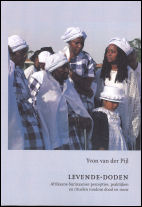'Living-Dead:
African-Surinamese perceptions, practices and rituals surrounding death and mourning'
describes and interprets the death culture of the descendants of African slaves, Creoles and Maroons, in Suriname. The book offers an integrated approach in which a wide range of attitudes comes to the fore, and uncommon (supernatural, bad or tragic) and common (natural, good) death are studied together. In this way, the study presents a comparative and reflexive perspective that reconciles ethnographic detail with middle range theories. The book is guided by two leitmotifs. The first concerning the coexistence of tradition and modernity or the phenomenon of multitemporal heterogeneity, arguing that African-Surinamese actors always live, on the one hand, in terms of conflicting demands, desires and expectations associated with voices of authority and, on the other, with the idiosyncratic aspirations of the individual. Processes like creolization, syncretization/anti-syncretization and de-/retraditionalization play a prominent role in this dialectic and, consequently, in the construction of African-Surinamese death culture as well as people's changing attitudes towards dying, death and mourning. Despite this dynamic nature, African-Surinamese culture is characterized by an inevitable constant that forms the second leitmotif of this study: the living-dead. Throughout this study it appears that within the African-Surinamese worldview and spiritual-religious orientation, (biological) death does not necessarily mean the end of life. Death rather implies a continuation of life in another form, in which contacts between the living and the deceased (or their spirits) are still possible. The dead are not dead: they are the living-dead who might interfere in people's lives - as spiritual entities or simply as a lasting remembrance. Living-dead have therefore to be handled with utmost care and respect, while the rituals regarding death, burial and mourning are considered as the most important rites de passage of African-Surinamese culture. Because of the enormous significance of the living-dead and the subsequent transitional rituals, an important part of this book consists of the description, analysis and interpretation of the ritual process that starts at the deathbed or even before the dying hour. In the conceptualization of death as a process and transition, I draw heavily on Van Gennep's model of rites of passage, Hertz's study of liminal rituals as well as his insights into the relationship between corpse, soul and mourners, and several contemporary followers of these founding fathers. This classical anthropological approach incorporates also contemporary perspectives and developments, like the medicalization, privatization and commercialization of death. As in other societies, Suriname is characterized by a 'denial of death' resulting in a detraditionalization of death culture. Because of Creole nationalism, black consciousness, back-to-the-roots movements and a nostalgic search for authenticity, especially by Dutch-Surinamese migrants, retraditionalization of death rituals takes place at the same time. 'Living-Dead' gives a thick description of these paradoxical trends and interprets African-Surinamese death culture, from a historical perspective, as a hybrid celebration in which (reinvented) traditions of different religious-spiritual orientations, modern glocalized cultural codes, and diverse forms of conspicuous consumption have blended.
keywords: Suriname, African-Surinamese culture & religion, death & mourning, rites of passage, burial rituals, creolization & syncretization
|


